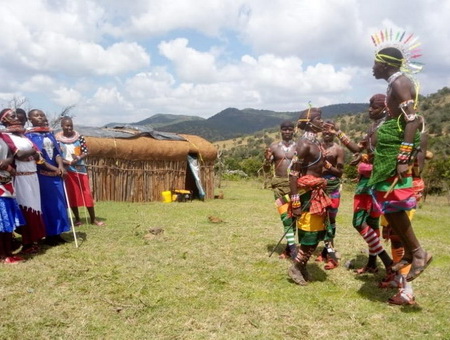

The Mukogodo live in the Mukogodo Forest of west central Kenya. They were originally an Eastern Cushite group, predating the Nilotes and Bantu in this area. There are no remaining speakers of the original language, called Yaaku.
The name Mukogodo is a Yaakunte word meaning people who live in rocks.
The Mukogodo represent a second wave of Cushite immigration into the Rift Valley area of East Africa. The earlier Southern Cushites were the first settlers we know of following the indigenous San (Bushmen).
The San were here first before the time of Christ. Then came the Southern Cushites in the first millennium AD, then Eastern Cushites, followed by the Highland Nilotes (Kalenjin Cluster), then the early Bantu.
Later came intermingled waves of Plains Nilotes (Maasai-Teso-Karamojong-Turkana), later Bantu (Logoli-Kuria-Ganda, etc.) and River-Lake Nilotes (Luo and related Uganda peoples still stretching up into the Waa River marshes in Sudan).
Various old Cushite groups in the Rift Valley of Kenya and Tanzania have become affiliated with various Nilotic tribes as clients, mostly as a self-defense for their own preservation under the various waves of Nilotic migration into their ancestral area.
The Mukogodo have affiliated with the Maasai. Most Mukogodo now speak Maasai and are referred to as the Mukogodo Maasai. The Mukogodo are referred to in the traditions of various Highland Bantu peoples like the Meru and Kikuyu as Mwoko.
The Maasai called these early Cushitic peoples by the name Dorobo. The "Dorobo" are not one tribe. Rather, the term Dorobo referred to the various original (Southern or Eastern Cushite) forest-dwelling hunter-gatherers. One connotation of "Dorobo" is poor people who do not have cattle! The Maasai term was taken into Swahili in the same form, and into Kikuyu as Ndorobo.
Among other people called "Dorobo" are the Okiek, the Mediak, the Mosiro and the El Molo. The Okiek speak Kipsigis, another Kalenjin language. The Mediak language is related to Nandi, probably from the original form of the early Kalenjin settlers. The Mosiro of Tanzania also speak a Kalenjin language, though many now speak Maasai.
The El Molo are also an Eastern Cushite group, related to the Somali and Rendille. They are reported to consist of 8 speakers of the old El Molo (Ol Molo) language, with a few dozen more speaking Samburu or Turkana. Older related peoples were referred to by Luhya groups as the Sirikwa, and were said to live in the ground. There are great hollows where the Luhya say these people used to live. (See also profile on the Dorobo Peoples.)
The Mukogodo have been completely absorbed into the Maasai culture and language. They consider themselves a sub-tribe of the Maasai and speak the Maasai language (Maa).
The current generation seem to have lost much of their ancient knowledge. In the last generation all the old people who still spoke Yaaku, the Mukogodos' Cushite language, passed away. The Mukogodo are now Maasai by language as well as culture.
The Mukogodo Maasai follow the Maasai age-grade customs, the moranship (warrior age-grade) and culture organized around cattle-herding and occasional raiding of their neighbours, even today. They are more traditional than the Maasai, though like the Maasai, changing conditions are causing them to make a transition to settled living and cultivation of maize (corn).
They follow the traditional religion of the Maasai, believing in one Creator God who is distant, but can be contacted by animal sacrifice and supplication in times of great need. Thus they are monotheist, as are most peoples of Africa, but maintain practices commonly referred to as animistic.
Holy men (called Laibon in Maasai) work magic for good or cast spells. The Mukogodo have no Laibon of their own, but utilize those of the neighboring Kalenjin people. They use certain charms and fetishes as the Maasai still do.
Subsistence. At the time of Mukogodo and Yaaku interaction, the latter lived by hunting and gathering. An area of particular focus appears to have been bee-keeping, a heritage maintained by the Mukogodo Maasai today.
The (Mukogodo) lifestyle revolved around hunting, beekeeping, trapping and gathering. They occasionally hunted and trapped both small and large animals besides their day to day foraging activities...Even though Mukogodo hunters did pursue a wide variety of species, the main source of meat in their diet was the rock hyrax because it was simple to capture.
— Mhando, 2008
Shelter. The Mukogodo made their homes in caves hence the appellation applied to them.
Tools. The main tools of the Mukogodo hunter were his bow and arrows. The latter which were carried in wooden quivers with leather lids and shoulder straps. Their shafts were made from a reedy plant and were fitted with iron tips. These tips were purchased in trade with their neighbors as the Mukogodo had no blacksmiths of their own.
Trade. The Mukogodo hunted rhinoceros for their horn, which they traded with their neighbors for livestock, crops, and manufactured goods like beads and iron.
The Mukogodo appear to have lived in association with the Yaaku in that the Mukogodo in whose localities the Yaaku settled, adopted the Yaakunte language. However, they maintained their hunter-gathering way of life.
In the present time, both the terms Yaaku and Mukogodo, sometimes Mukogodo Maasai are used to refer to a population living in Mukogodo forest west of Mount Kenya.[
Sources: